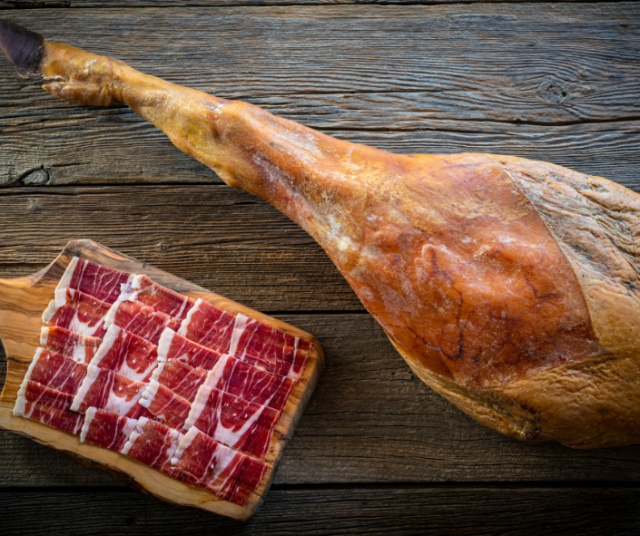In the annals of world gastronomy, few delicacies compare to Iberian ham, a culinary treasure from Spain that has conquered palates around the world. With its unmistakable flavor, delicate texture and meticulous production process, Iberian ham stands as one of the most appreciated and coveted products by lovers of good food.
History and Tradition
Iberian ham has roots that go back centuries in the Iberian Peninsula. Its origins are intertwined with the raising of Iberian pigs, a practice that has been maintained for millennia in the southwestern region of Spain, especially in places such as Extremadura, Andalusia and the Sierra de Huelva. Iberian pigs, descendants of native species of the peninsula, are raised in specific conditions that significantly influence the quality and flavor of their meat.
Production process
The production process of Iberian ham is an art that combines tradition, knowledge and patience. It all begins with the raising of Iberian pigs in pastures, extensive grazing areas and holm oak and cork oak forests. Here, the pigs feed on acorns during the montanera, a crucial phase that gives Iberian ham its characteristic flavor and exceptional tenderness.
After the montanera, the pigs are slaughtered and their hind legs are prepared for the healing process. A "V"-shaped cut is made at the top of the leg, followed by a salting process that can last several weeks. Then, the hams are washed and left to rest to remove excess salt.
The next step is drying, where the hams are hung in warehouses with controlled temperature and humidity conditions. This period can last several months or even years, during which the ham develops its unique flavor and aroma as controlled fermentation occurs. Finally, the hams are ready for packaging and distribution.
Varieties and Designations of Origin
Within the world of Iberian ham, there are different varieties that are distinguished by factors such as the breed of pig, the diet and the curing process. The main categories are:
Acorn-fed Iberian Ham: It comes from Iberian pigs fed exclusively with acorns during the montanera. It is the most appreciated variety and is distinguished by its intense flavor and soft, creamy texture.
Iberian Cebo de Campo Ham: It comes from Iberian pigs fed with a diet based on acorns and natural grasses in the pasture, but also supplemented with feed. Although lower in quality than acorn-fed, it still offers exceptional flavor.
Iberian Cebo Ham: It comes from pigs fed exclusively with feed and without access to the montanera. Although cheaper, it lacks the characteristic flavor and texture of acorn and field bait varieties.
Each of these varieties can be supported by a Denomination of Origin, a quality seal that certifies compliance with specific production and geographical origin standards. Some of the most recognized Designations of Origin include the Dehesa de Extremadura Designation of Origin, the Guijuelo Designation of Origin and the Jabugo Designation of Origin.
Tasting and Pairing
Tasting Iberian ham is a ritual, where both its sensory qualities and its rich history and tradition are appreciated. When cutting the ham, we aim to obtain thin slices that allow us to appreciate the delicacy of its texture and the intensity of its flavor. It is important that the ham be served at room temperature to highlight all its qualities.
As for pairing, Iberian ham harmonizes especially well with medium- to intense-bodied red wines, such as a good Rioja or a Ribera del Duero. It can also be accompanied with cava or dry white wines, as well as craft beers or vermouths. As for accompaniments, crusty bread and quality extra virgin olive oil are recommended.
Myths and realities
Iberian ham has been the subject of numerous myths and misunderstandings over time. One of the most common is the belief that the color of the ham's fat indicates its quality. In reality, the color may vary due to factors such as the pig's diet and the curing process, but it is not necessarily related to the quality of the product.
Another common myth is that all Iberian hams are acorn-fed. As we have seen, there are different categories of Iberian ham, each with its own characteristics and production processes. It is important to find out about the specific variety when purchasing an Iberian ham to ensure a satisfactory tasting experience.
Iberian Ham in Global Gastronomy
As Spanish gastronomy has gained worldwide recognition, Iberian ham has become an exceptional culinary ambassador. Restaurants around the world include this delicacy on their menus, and international chefs use it in a variety of creative dishes ranging from traditional tapas to innovative gastronomic fusions.
At gastronomic events and international fairs, Iberian ham usually occupies a prominent place, attracting fans and curious people eager to discover its secrets and savor its exquisite quality. Furthermore, its presence in gourmet stores and online has facilitated its access to consumers around the world, thus contributing to its growing popularity and demand.
In each slice a story of dedication and excellence is revealed, a legacy that transcends borders and that will last on the palates of generations to come. Therefore, by savoring Iberian ham, we are not only enjoying an incomparable delicacy, but also honoring an ancient tradition that deserves to be celebrated and preserved forever.
